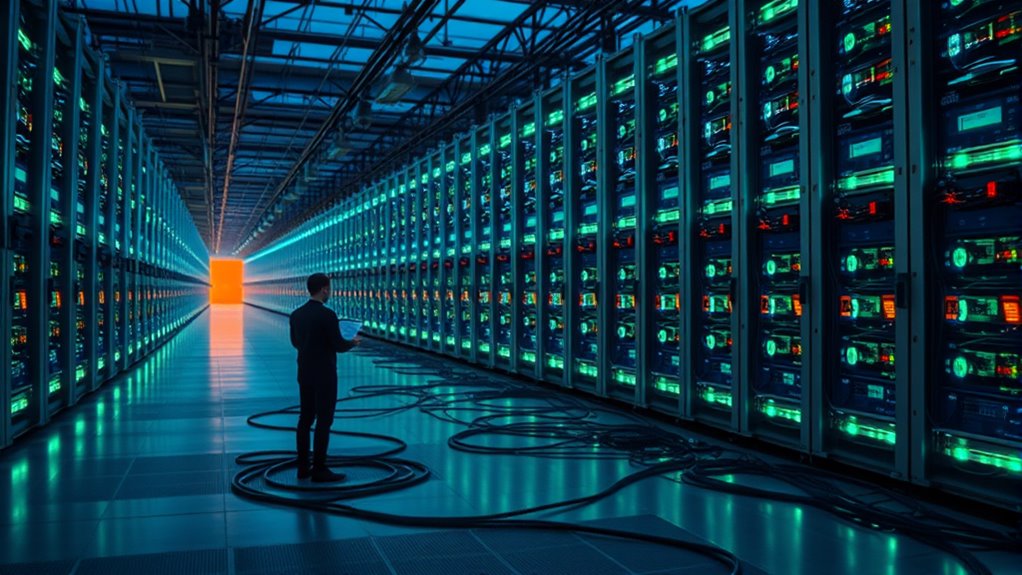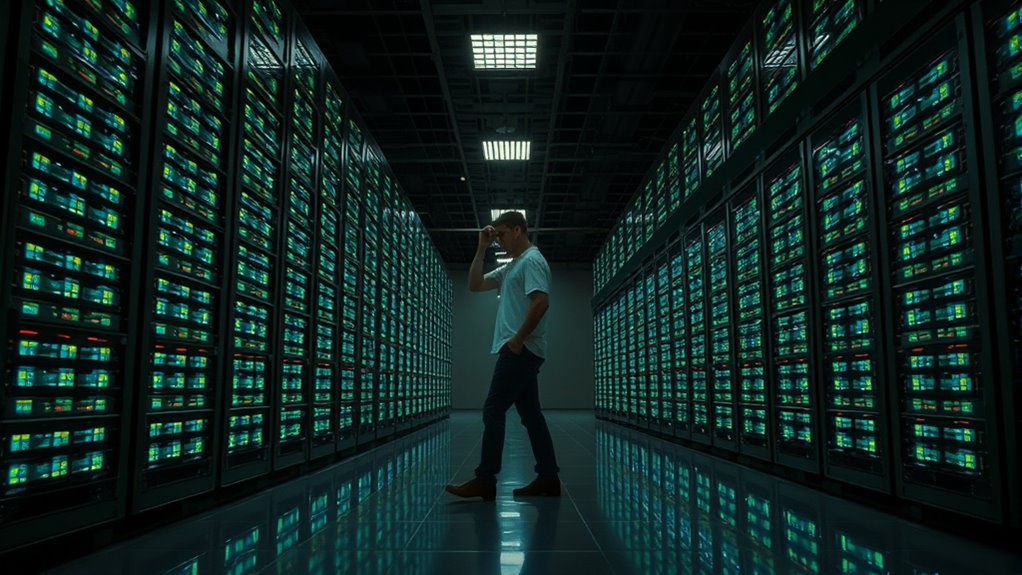Streaming consumes significant energy through data center operations, which produce greenhouse gas emissions, especially when using high-resolution videos like 4K. Your viewing habits, such as length and quality, directly impact this footprint. To shrink it, consider lowering video quality, downloading content for offline use, and supporting services that use renewable energy. Small changes can make a difference—continue to explore ways you can reduce your digital environmental impact effectively.
Key Takeaways
- Streaming increases energy consumption due to data center operations and high-resolution content requirements.
- Data centers’ cooling systems often consume nearly half of their energy, impacting overall carbon emissions.
- Choosing lower video resolutions and downloading content for offline viewing reduces data processing and energy use.
- Supporting renewable energy-powered data centers and eco-conscious streaming services can significantly lower your carbon footprint.
- Small habit changes, like limiting streaming hours and favoring sustainable providers, help collectively reduce environmental impact.

Have you ever wondered how your favorite streaming habits impact the environment? Every time you click play on a show or a movie, it triggers a complex chain of events involving energy consumption and data centers. These data centers are the backbone of streaming services, storing and transmitting the vast amount of content you enjoy. But they require enormous amounts of electricity to operate, often relying on energy sources that produce greenhouse gases. The more you stream, the more energy is used, and the higher the carbon footprint becomes. Understanding this connection helps you see how your viewing choices contribute to environmental impact.
Streaming habits impact the environment through energy use and data center emissions.
Data centers are designed to handle massive data flows, and their servers run 24/7 to ensure seamless streaming. These facilities consume a significant amount of electricity, not only for powering the servers but also for cooling systems that prevent overheating. Cooling can account for nearly half of a data center’s energy use, making efficiency a critical factor. Some data centers are powered by renewable energy sources, but many still depend on fossil fuels, which release carbon dioxide into the atmosphere. This reliance intensifies the environmental impact of streaming, especially as demand for high-definition content increases. Streaming in 4K or higher resolution demands even more data processing and bandwidth, further escalating energy consumption.
To shrink your streaming carbon footprint, start by being mindful of how much you stream. Reducing the number of hours you spend binge-watching or opting for lower resolution videos can make a difference. You can also choose streaming services that prioritize sustainability, as some companies invest in renewable energy or carbon offset programs. Additionally, downloading content for offline viewing can help you avoid repeatedly streaming the same videos, reducing the strain on data centers. When possible, stream during times when renewable energy is more available in your region, or use devices connected to energy-efficient networks. Supporting green data centers and their sustainable practices is another impactful step toward reducing your digital footprint.
Another step to take is supporting initiatives that aim to make data centers greener. Many tech companies are investing in renewable energy projects and improving infrastructure efficiency. Your choices as a consumer—such as supporting eco-conscious services or advocating for greener technology—can contribute to broader change. Ultimately, small adjustments in your streaming habits can collectively lower energy consumption and reduce the environmental impact tied to data centers. By staying conscious of your digital footprint, you help push the industry toward more sustainable practices, making your entertainment habits more environmentally friendly without sacrificing enjoyment.
Frequently Asked Questions
How Does Streaming Quality Affect Energy Consumption?
Streaming quality directly impacts energy consumption because higher quality videos require more data transfer and processing. When you choose lower quality settings, you enable bitrate optimization and better content compression, which reduce the amount of data transmitted. This means less energy is needed for servers and devices. So, by adjusting your streaming quality, you can help decrease energy use and lessen your environmental impact.
Are Renewable Energy Sources Used by Streaming Platforms?
You might wonder if streaming platforms use renewable energy. Many are increasingly adopting renewable energy sources like wind and solar to power their data centers. Some also pursue green certifications to prove their commitment to sustainability. By supporting platforms that prioritize renewable energy and hold green certifications, you help reduce the environmental impact of streaming. Your choices can encourage more companies to shift to cleaner energy solutions.
What Is the Environmental Impact of Data Center Cooling?
You should understand that data center cooling impacts the environment considerably. Server farms generate a lot of heat, requiring powerful cooling systems to keep equipment running efficiently. These systems often consume substantial energy, leading to higher carbon emissions unless they use renewable energy. To reduce this impact, many companies are upgrading cooling technologies, improving energy efficiency, and integrating sustainable practices, helping to lessen their overall environmental footprint.
How Do Device Types Influence Streaming’S Carbon Footprint?
Imagine your streaming device as a tiny boat steering through a vast digital ocean. The more efficient your streaming hardware, the less energy it consumes, reducing its carbon footprint. Different device types—smartphones, smart TVs, tablets—vary in device efficiency, impacting how much CO2 they produce during streaming. Choosing energy-efficient hardware helps you sail smoother and greener through your favorite shows, making a real difference in protecting our environment.
Can Peer-To-Peer Streaming Reduce Overall Emissions?
Peer-to-peer benefits can help reduce overall emissions by improving network efficiency. When you use peer-to-peer streaming, your device shares data directly with others, lessening the load on central servers. This decreases energy consumption across the network, leading to lower carbon emissions. So, by choosing peer-to-peer options, you contribute to a more efficient streaming system that benefits the environment and reduces your carbon footprint.
Conclusion
So, next time you binge your favorite series, remember—it’s not just your eyes glued to the screen, but also the planet. Ironically, streaming feels so effortless that we forget it comes with a hefty environmental price tag. If you really care about reducing your carbon footprint, maybe consider turning off that endless stream once in a while. After all, saving the planet shouldn’t be just another episode you skip.









